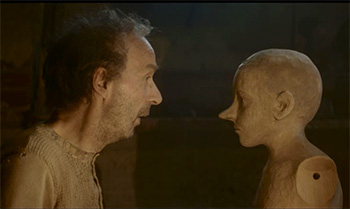Tip #1296: The Fairy-Tale Effects in Pinocchio
… for Visual Effects
Tip #1296: The Fairy-Tale Effects in Pinocchio
Larry Jordan – LarryJordan.com
Take a deep dive into on-camera visual effects, aided by CGI.


This article, written by Ian Failes, first appeared in VFXVoice.com. This is a summary.
Matteo Garrone’s Pinocchio, an Italian-made re-telling of the classic tale by Carlo Collodi, is a film that draws upon both practical and digital effects to tell its story of the central puppet character wanting to become a real boy.
Behind the majority of the digital visual effects work was One Of Us, based in London, which augmented several scenes that made use of on-set makeup and prosthetics, as well as delivering a number of fully-CG elements that had to stay within the fairy-tale realm of the story.
Here, One Of Us Visual Effects Supervisor Theo Demiris breaks down a number of the studio’s characters and shots from the film.
“Pinocchio as a character was entirely filmed in-camera made possible by some incredible prosthetics developed by Mark Coulier and his team. Our intervention consisted mainly of cleaning up creases and imperfections, usually around the hands and neck area.”
Donkey underwater: “We knew from the very beginning that this was going to be entirely a VFX shot. This moment was all about hitting the emotional beats of the story, and we very quickly realized that this also meant that it had to be a very long shot, 1,000 frames to be exact. The donkey had to lose its breath and then very slowly be enveloped in a shimmering school of fish.
“Once we blocked the Donkey animation, we started working on the environment and the behavior of the fish. The environment had to feel Mediterranean – highly detailed but murky and poetic. The fish had to behave beautifully but also realistically. For that, Matt Noris, one of our Senior FX Artists, put together a crowd simulation that was flexible and easy to art-direct. Once we had all the ingredients out from CG, Guillaume Menard, our Comp Supervisor, put it together himself and introduced a lot of real-life elements in the environment.”
“The most notable of effect in terms of work was the character of the Tuna. Not only was it a big fish, but also had to interact with the surrounding water and performances. For this, the actor was in prosthetics on the face with the rest his body hidden away underwater. We then kept only the very front of his performance and attached a CG body behind him. To do so seamlessly we had to track the head and attach the body while reverse-engineering his head movements and adjusting the animation to make them feel as if they were coming from the body rather than the other way around. It had, after all, to feel as if the body was floating and driving the movements of the head.”
EXTRA CREDIT
There’s a lot more to his discussion, along with images illustrating some of their VFX work in the article linked above.


Leave a Reply
Want to join the discussion?Feel free to contribute!